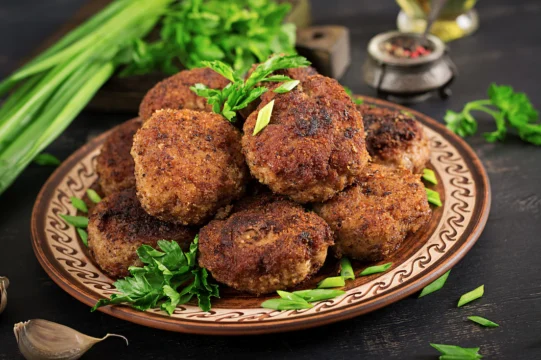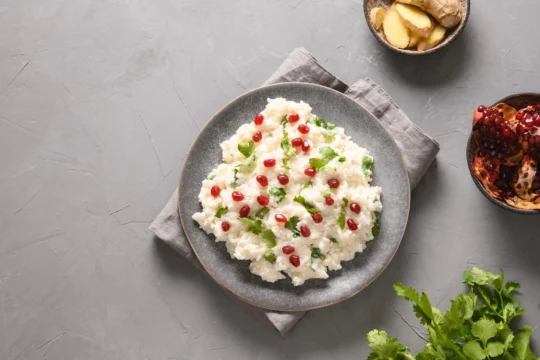- You have no items in your shopping cart
- Continue Shopping

India’s most well-known street snack, pav bhaji, is believed to be created in Mumbai, Maharashtra, in the 1850s. The dish was initially developed as a quick-to-prepare, wholesome lunch option for textile mill workers who wanted something hearty and portable.
Pav bhaji is now a beloved meal that appeals to individuals of all ages and socioeconomic backgrounds. It is frequently offered at weddings, parties, and other special occasions. High-end restaurants have even put it on their menus. Despite its humble beginnings, pav bhaji has grown to be a valued component of Indian cuisine and is still a well-liked and reasonably priced choice for people seeking a pleasant and substantial dinner.
A popular street snack from Mumbai, India is the classic pav bhaji. Pavs, soft buns flavoured with butter, are topped with a spicy and savoury mixture of mashed veggies. The meal is typically created with a combination of cooked and mashed vegetables, including potatoes, tomatoes, onions, peas, cauliflower, and carrots, to create a thick, spicy, and delectable bhaji. The dish is often accompanied by toasted pav buns that have been butter-slathered and topped with fresh coriander leaves and lemon juice.
Table of Contents
The popularity of pav bhaji recipe
Indian and international food enthusiasts both like this snack. It is a dish that may be eaten as a quick snack, a big dinner, or a hefty lunch. For added flavour and spice, the meal is frequently served hot with chopped onions, lemon wedges, and green chillies. Everyone of all ages enjoys the Indian street snack pav bhaji.
Street food of Mumbai
Mumbai is renowned for its thriving street food scene, which is a fusion of several regional and international cuisines. The city’s street cuisine, which ranges from mouthwatering vada pav to sour bhel puri, is renowned for its distinctive flavour and reasonable costs. The origins of Mumbai’s street cuisine may be found in the early 19th century when the working-class residents of the city began to enjoy it more frequently.
The vada pav, a deep-fried potato patty packed in a bun with chutneys and spices, is one of the most well-liked street meals in Mumbai. It was created by a street vendor named Ashok Vaidya in the 1960s, and it has since become synonymous with Mumbai’s street food culture.
Bhel puri, which is a spicy and sour concoction of puffed rice, sev, veggies, and chutneys, is another well-known street snack from Bombay. It is thought to have its roots in Mumbai’s Gujarati community from the 1930s to the present and has since established itself as a mainstay of the city’s street food scene.
Some well-liked street meals in Bombay are sev puri, a crunchy snack topped with chutneys, veggies, and sev, and pav bhaji, a fiery vegetable curry served with a buttery bread bun. Kebabs, chaat, and dosas come in a huge variety in the city’s street food scene.
Mumbai’s street food vendors have developed a culinary tradition that is distinctive to the city and has become a vital component of its character.
Ingredients to prepare pav bhaji masala
- Tomatoes – 2
- Assorted vegetables (potato, cauliflower, beans, peas) – 300g
- Finely chopped onion – 1 big
- Ginger garlic paste – ½ tsp
- Pav bhaji masala – 1 pack ( 30g)
- Lime juice – 1 tbsp
- Chopped coriander leaves – for garnishing
- Oil – 2 tbsp
- Butter
Method to prepare pav bhaji masala
- Boil 2 tomatoes with enough water until the skin of the tomatoes starts cracking.

2. Let the boiled tomatoes cool down and then transfer to a blender.
3. Blend the tomatoes into a smooth paste and keep it aside. Tomato puree is now ready.
4. Pressure cook or steam around 300g of assorted vegetables of your choice, you can use vegetables like potato, cauliflower, peas, beans etc.

5. Once the vegetables are cooked mash them well and keep them aside.

6. Heat a deep-bottomed pan and add 2 tbsp oil; as the oil warms up, add 1 finely chopped onion and fry well.

7. Add ½ tsp ginger garlic paste and tomato puree and mix well.

8. Let the tomatoes cook for 2 to 3 minutes on medium flame.
9. Add 1 pack of pav bhaji masala and mix well.

10. Now add the mashed vegetables and ½ cup of water and mix well.

11. Cook well on low flame for 10 minutes.
12. Add salt if needed.
13. Pav bhaji masala is now ready. Add a scoop of butter, finely chopped coriander leaves and 1 tbsp lemon juice on top.

14. Take a pav and slice them in half, heat a skillet, add 1 tsp butter, sprinkle pav bhaji masala powder on the skillet and mix well.
15. Place the sliced pav in the skillet and fry until the pav turns golden brown.
16. Serve the buttered pav with the bhaji masala and enjoy the classic pav bhaji masala with a cup of coffee or tea.

Tips and tricks to prepare pav bhaji masala
- You can either pressure cook or steam cook the vegetables.
- Vegetables including cauliflower, potatoes, carrots, peas, capsicum, and french beans are typically added in pav bhaji recipe.
- The final flavour and colour of the bhaji will vary depending on how much of the vegetables are used.
- To fit your preferences, the spice powders can be easily changed. As a result, adjust their amount to suit your tastes.
- Using butter gives an authentic taste to the pav bhaji recipe. You can skip the butter if you don’t prefer it.
Recipe Card

Method to prepare pav bhaji masala
Ingredients
- 2 Tomatoes
- 300 g Assorted vegetables potato, cauliflower, beans, peas
- 1 big Finely chopped onion
- ½ tsp Ginger garlic paste
- 1 pack 30g Pav bhaji masala
- 1 tbsp Lime juice
- Chopped coriander leaves for garnishing
- 2 tbsp Oil
- Butter
Instructions
- Boil 2 tomatoes with enough water until the skin of the tomatoes starts cracking.
- Let the boiled tomatoes cool down and then transfer to a blender.
- Blend the tomatoes into a smooth paste and keep it aside. Tomato puree is now ready.
- Pressure cook or steam around 300g of assorted vegetables of your choice; you can use vegetables like potato, cauliflower, peas, beans etc.
- Once the vegetables are cooked mash them well and keep it aside.
- Heat a deep-bottomed pan and add 2 tbsp oil; as the oil warms up, add 1 finely chopped onion and fry well.
- Add ½ tsp ginger garlic paste and tomato puree and mix well.
- Let the tomatoes cook for 2 to 3 minutes on medium flame.
- Add 1 pack of pav bhaji masala and mix well.
- Now add the mashed vegetables and ½ cup of water and mix well.
- Cook well on low flame for 10 minutes.
- Add salt if needed.
- Pav bhaji masala is now ready. Add a scoop of butter, finely chopped coriander leaves and 1 tbsp lemon juice on top.
- Take a pav and slice them in half, heat a skillet, add 1 tsp butter, sprinkle pav bhaji masala powder on the skillet and mix well.
- Place the sliced pav in the skillet and fry until the pav turns golden brown.
- Serve the buttered pav with the bhaji masala and enjoy the classic pav bhaji masala with a cup of coffee or tea.
Video
FAQ’s
What is Pav Bhaji masala made of?
The basic whole spices coriander seeds, cumin seeds, black cardamoms, star anise, green cardamoms, fennel seeds, dried ginger, red chilies, black pepper, cinnamon, cloves, and dried mango are used to make the spice powder known as pav bhaji masala.
How to cook the vegetables for pav bhaji?
You can pressure cook or steam cook the vegetables.
What kind of vegetables can be used for pav bhaji?
Any vegetables of preferred choice like cauliflowers, carrot, peas, potato, beans, capsicum etc can be used for pav bhaji masala.
Which city is famous for pav bhaji in India?
Mumbai
Served with a soft bread roll (pav) and a tomato-based vegetable sauce (bhaji), Pav Bhaji is a fast food item from Mumbai (Bombay), India.




